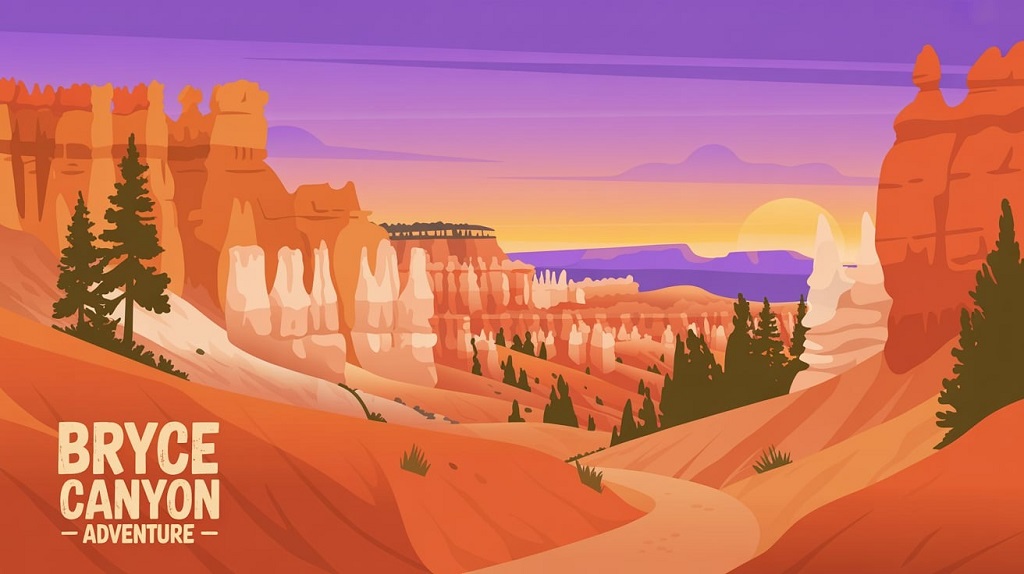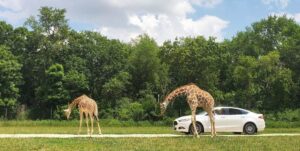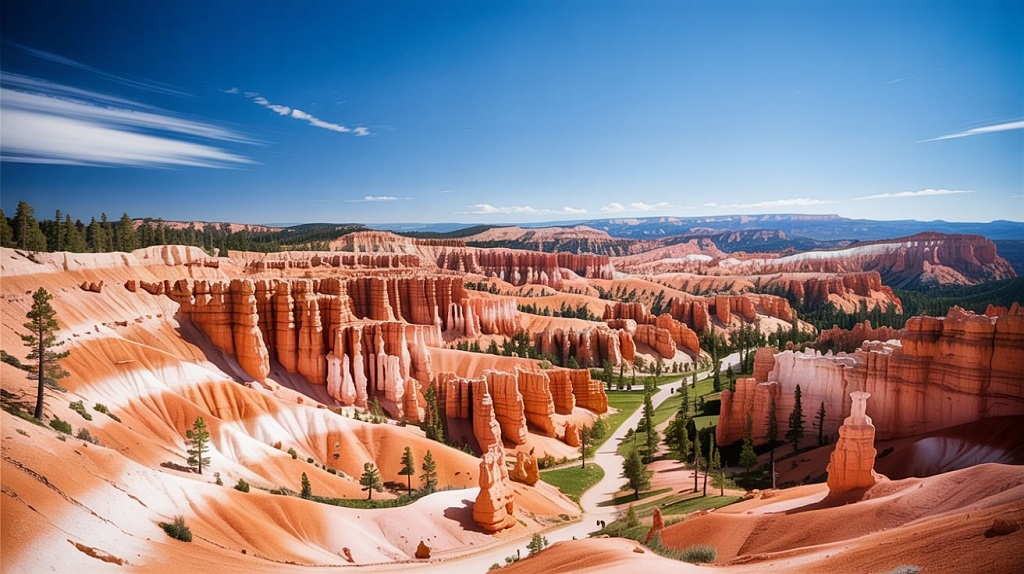
Imagine standing on the edge of a vast amphitheater, where thousands of towering rock spires—known as hoodoos—glow in shades of fiery red, orange, and pink as the first rays of sunlight pierce the horizon. These whimsical formations, sculpted by millions of years of erosion, create a landscape that feels otherworldly, like stepping onto the set of a fantasy film. If you’ve ever dreamed of exploring Utah’s iconic national parks but have limited time, Bryce Canyon National Park offers an unforgettable experience in just one day. This guide will walk you through a carefully crafted itinerary, packed with hiking trails, scenic viewpoints, and practical tips to make the most of your visit. Whether you’re a seasoned hiker or a casual sightseer, you’ll discover why Bryce Canyon is a must-see gem in the American Southwest.
Why Visit Bryce Canyon National Park?
Bryce Canyon isn’t your typical canyon—it’s actually a series of natural amphitheaters carved into the Paunsaugunt Plateau. At elevations ranging from 8,000 to 9,000 feet, the park boasts the world’s largest collection of hoodoos, those tall, thin rock pillars that seem to defy gravity. Formed by frost-wedging and acidic rainwater dissolving the limestone, these geological wonders provide a stunning backdrop for outdoor adventures. The park spans about 35,835 acres and is part of Utah’s “Mighty Five” national parks, alongside Zion, Arches, Canyonlands, and Capitol Reef.
For a day trip, focus on the Bryce Amphitheater area, which concentrates the most dramatic views and accessible trails within the first few miles of the park’s main road. This makes it ideal for visitors short on time, allowing you to hit the highlights without feeling rushed. Plus, with dark skies perfect for stargazing and diverse wildlife like pronghorn antelope and prairie dogs, Bryce Canyon delivers a mix of natural beauty and serenity.
Planning Your One-Day Trip: Essentials to Know
Before diving into the itinerary, let’s cover the basics to ensure a smooth visit. Bryce Canyon is open year-round, but the best time to go is spring (April-May) or fall (September-October) when temperatures are mild (50-70°F) and crowds are thinner. Summers can be hot and busy, while winters bring snow, making some trails slippery but offering a magical, less-crowded experience. As of 2025, the park’s shuttle service runs from April to October, helping reduce traffic congestion in the amphitheater area.
Getting There and Entrance Fees
Bryce Canyon is located in southern Utah, about 4 hours from Las Vegas or Salt Lake City by car. The nearest airport is in Cedar City (about 1.5 hours away). Drive Highway 63 south from Bryce Canyon City to enter the park. Entrance fees are $35 per private vehicle (valid for 7 days), $30 per motorcycle, or $20 per person on foot or bike. Youth under 16 enter free. If you plan to visit multiple parks, consider the America the Beautiful Annual Pass for $80. No reservations are needed for entry, but arrive early (before 8 AM) to beat the crowds, especially in peak season.
Using the Park Shuttle
To make navigation easy, hop on the free shuttle, included with your entrance fee. In 2025, it operates from 8 AM to 6-8 PM depending on the month, with buses every 15 minutes. Key stops include the Visitor Center, Bryce Point, and Sunset Point. It’s wheelchair-accessible and accommodates bikes, but no pets allowed. Parking is available at the Shuttle Station in Bryce Canyon City or near the Visitor Center—perfect for avoiding restricted areas for larger vehicles.
What to Pack and Safety Tips
Pack layers for variable weather, sturdy hiking shoes, plenty of water (at least 1 liter per person per hour of activity), sunscreen, snacks, and a hat. High elevation means thinner air, so take it slow if you’re not acclimated. Stay on marked trails to avoid erosion and falls—hoodoos can be unstable. Watch for wildlife, and never approach animals. In summer, thunderstorms are common after noon, so check weather forecasts. For emergencies, cell service is spotty, so download offline maps.
Your One-Day Bryce Canyon Itinerary: From Dawn to Dusk
This itinerary assumes you have a full day, starting at sunrise and ending at sunset. It’s designed for moderate fitness levels, combining short hikes, viewpoints, and downtime. Total walking: about 5-7 miles. Adjust based on your pace and interests.
Morning: Sunrise Magic and Iconic Hikes (6 AM – 11 AM)
Kick off your day with a breathtaking sunrise at Bryce Point, one of the park’s premier viewpoints. Arrive by 6 AM (sunrise times vary; check apps like PhotoPills) to watch the hoodoos ignite in golden light. The panoramic vista over the amphitheater is mesmerizing, with rows of spires stretching into the distance. It’s a short walk from the parking lot, making it accessible for all.
Next, head to the Visitor Center (opens at 8 AM) for orientation. Watch the 22-minute park film on geology and history, pick up maps, and grab Junior Ranger booklets if traveling with kids. From here, embark on the highlight of any Bryce Canyon day trip: the Queen’s Garden/Navajo Loop Trail. This 3-mile moderate loop (about 2-3 hours) descends 600 feet into the amphitheater, weaving through hoodoos, slot canyons, and pine forests. Start at Sunrise Point for the easier Queen’s Garden section, where you’ll spot the famous Queen Victoria hoodoo resembling a regal figure. Connect to the Navajo Loop for dramatic switchbacks through Wall Street—a narrow canyon flanked by towering Douglas firs. It’s strenuous on the ascent, but the views are worth every step. Pro tip: Go clockwise to tackle the steeper part uphill.
If you’re short on time or prefer easier paths, opt for the Rim Trail—a flat, paved walkway along the amphitheater edge from Sunrise to Sunset Point (1-2 miles one way). It offers continuous vistas without the elevation change.
Midday: Scenic Drive and Viewpoints (11 AM – 2 PM)
After your hike, refuel with a picnic at Sunset Point or grab lunch at the Bryce Canyon Lodge (try the Navajo tacos for a local twist). Then, take the 18-mile Southern Scenic Drive south to Rainbow Point, the park’s highest elevation at 9,115 feet. This out-and-back route takes about 1-2 hours with stops and showcases diverse landscapes, from forests to distant views of the Grand Staircase-Escalante.
Key stops include:
- Natural Bridge: A massive red rock arch framing the sky—perfect for photos.
- Black Birch Canyon: Overlooks layered cliffs and valleys.
- Ponderosa Canyon: Spot ancient bristlecone pines, some over 1,600 years old.
- Rainbow Point: The endpoint with 100-mile vistas on clear days. Hike the short Bristlecone Loop Trail (1 mile, easy) for a quiet forest stroll.
Drive back north, stopping at viewpoints you missed on the way down. This drive highlights Bryce Canyon’s unique geology beyond the main amphitheater, giving a fuller picture of the park’s vastness.
Afternoon: More Trails and Exploration (2 PM – 5 PM)
Return to the amphitheater for afternoon adventures. If energy allows, hike the Peekaboo Loop Trail (5.5 miles, strenuous, 3-4 hours)—a figure-eight path through hoodoos, tunnels, and arches. For a shorter option, try the Mossy Cave Trail just outside the park entrance (0.8 miles, easy). It leads to a dripping alcove and waterfall (rare in the desert) plus Tropic Ditch, an early settler irrigation canal.
Alternatively, relax at Inspiration Point for multi-level views of the Silent City—a dense cluster of hoodoos resembling a skyline. It’s less crowded than Bryce Point and ideal for photography. Use the shuttle to hop between spots efficiently.
Evening: Sunset and Stargazing (5 PM – Dark)
Cap your day with sunset at Inspiration or Sunset Point. As the sun dips, the hoodoos cast long shadows, turning the landscape into a palette of deep crimson and purple. It’s a serene moment to reflect on the day’s wonders.
If staying nearby, join a ranger-led full moon hike (check the calendar for dates) or stargaze—Bryce has some of the darkest skies in the U.S., with the Milky Way visible on clear nights. Head out via the shuttle or your vehicle, grabbing dinner in Bryce Canyon City at spots like Ruby’s Inn for hearty American fare.
Read More Also: Explore Biloxi, Mississippi
Beyond the Basics: Tips for an Unforgettable Experience
To elevate your Bryce Canyon day trip:
- Photography Tips: Use a wide-angle lens for hoodoos; golden hour (sunrise/sunset) is prime time. Apps like Sun Surveyor help plan shots.
- Family-Friendly Adjustments: Skip strenuous hikes for the Rim Trail and Visitor Center activities. The Junior Ranger program keeps kids engaged.
- Sustainable Travel: Follow Leave No Trace principles—pack out trash, stay on trails. Use the shuttle to minimize emissions.
- Weather and Accessibility: Trails can be icy in winter; rent snowshoes if needed. Many viewpoints are wheelchair-friendly.
- Nearby Attractions: If extending your trip, combine with Zion National Park (1.5 hours away) for a multi-park adventure.
This itinerary covers the essence of Bryce Canyon, blending adventure, education, and awe-inspiring scenery. With about 3 million visitors annually, planning ahead ensures you avoid peak-hour waits.
Read More Also: Things to Do in Tampa With Kids
Final Thoughts and Your Next Step
One day in Bryce Canyon National Park is enough to fall in love with its surreal hoodoos, invigorating hikes, and panoramic vistas, but it might just inspire you to return for more. From the thrill of descending into the amphitheater to the peace of a sunset overlook, this Utah treasure delivers memories that last a lifetime.







